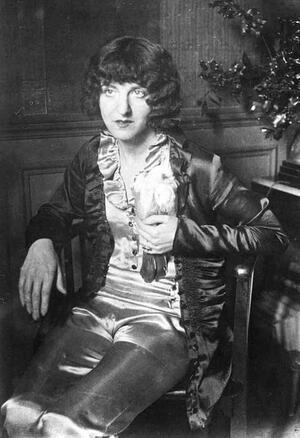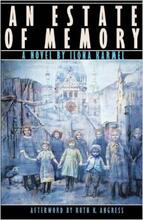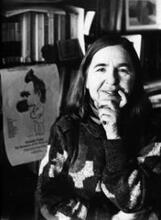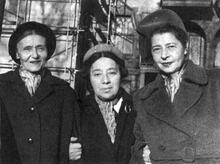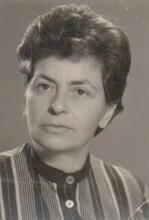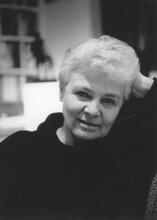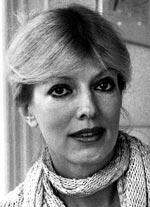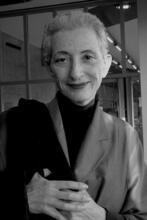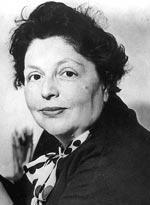Claire Goll
In 1917, Claire Goll was studying medicine and psychology in Geneva and writing for newspapers and pacifist journals when she fell in love with fellow writer Yvan Goll. In 1918, she published a poetry collection and a set of short stories. In 1919, the couple moved to Paris, where Goll wrote reviews and multiple novels, published collections of short fiction, translated several contemporary novels, edited collections of poetry, and wrote several volumes of love poetry with her husband. Fear of war and of persecution by the Nazis led the Golls to emigrate to America in 1939, settling in Brooklyn. There, Goll again wrote for pacifist publications, published short fiction, and translated a number of works. After her husband’s death, Goll printed Yvan’s unpublished work and continued her own writing.
Overview and Early Life
“I have loved a few men and more than a few have loved me, but it was not until I reached seventy-six that I had my first orgasm.” The posthumously published memoir, Ich verzeihe keinem (I Forgive No-one), suggests something of the scandal that Claire Goll was able to provoke throughout her life. But her titillating sexual explicitness is quite different from the scandal triggered by her accusations that Paul Celan had plagiarized from her late husband’s poetry—accusations that some believe contributed to Celan’s suicide ten years later.
Single-mindedness and shamelessness of this order are leitmotifs in Claire Goll’s life. She was born Klara Liliane Aischmann on October 29, 1890 in Nuremberg. She grew up in Munich as the second child of a well-to-do assimilated German-Jewish family: her mother, Malvine, came from a family of bankers, and her father Joseph was a trader in hops, acting as the Argentinean Consul. Claire’s beloved brother and sole confidant, Alfred (whom she called Justus in some of her autobiographical writings), was five years older than she, and his suicide at the age of sixteen was a profound psychological blow. Claire’s childhood is documented in a series of semi-fictional, semi-autobiographical, often overlapping prose-writings: Education barbare (Barbaric Education), Le Ciel volé (Stolen Sky), Der gestohlene Himmel (ditto), Ballerine de la peur (Ballerina of Fear), and Traumtänzerin (Dream Dancer). These depict her mother as an unfeeling, perverse and even brutal woman, and the first of them was (unwittingly) published at about the time Malvine was deported to Theresienstadt. (The official date of her death is September 19, 1942, the day on which she was transported to Auschwitz.)
In 1911 Klara married a student, Heinrich Studer, and moved to Leipzig. Their daughter Doralies was born on May 6, 1912, but by 1917 they were divorced. Studer’s infidelities were legion, but her own (allegedly with Kurt Wolff) was the legal reason why she lost custody of Doralies, who was sent to Zurich to live with Studer’s parents; they never developed a close relationship. Early in 1917 Goll also moved to Switzerland, but to Geneva where she studied medicine and psychology and earned a living by contributing to a range of newspapers and pacifist journals. It was here, on February 10 of the same year, that she first met Yvan (Iwan) Goll (one of the pseudonyms used by the Lorrainer Isaac Lang), whom she was to marry officially on July 21, 1921. They moved to Zurich and Ascona before settling in Paris in November 1919. Despite turbulence and infidelity on both sides—including Claire’s affair with Rainer Maria Rilke, by whom she claimed to have been pregnant—Goll remained the focus of Claire’s life until his death from leukemia in 1950. Thereafter she devoted herself to maintaining and promoting her husband’s memory with unflagging (but often editorially unreliable) publications and re-issues of his work.
Early Writing Career in Europe
Claire’s own literary activity had been stimulated by the extraordinary community of writers and artists in Switzerland during World War I. In Paris the Golls hosted gatherings of many of the most exciting cultural figures of the French avant-garde and became an almost iconic couple. Alongside fashion, art, film, and theater reviews, Claire published collections of short fiction (Die Frauen erwachen [Women Awaken], Der gläserne Garten [The Glass Garden]) and volumes of verse (Mitwelt; Lyrische Films [Shared World; Lyrical Films]). She translated several contemporary novels, edited important international collections of poetry, and with Yvan wrote several joint volumes of love poetry (including Poèmes d’amour [Poems of Love], Poèmes de jalousie [Poems of Jealousy]), and Poèmes de la vie et de la mort [Poems of Life and Death]). She was as at home writing in French as she was in German. The theme of her most famous novel, Der Neger Jupiter raubt Europa (The Negro Jupiter Rapes Europa)—sexual and racial relations between a black African prince and a white Franco-Swedish bourgeoise—was topical in the Paris of the Jazz era. There is evidence, however, to suggest that the novel dates from Claire Goll’s time in Switzerland, and it has been shown (by Hausdorf, 1990) to be a reflection, too, on the situation of Jews in the post-war period. Color tensions are overlaid with the metaphorical comparison of black with Jewish as Jupiter Djilbuti suggests, “Perhaps we are the black Jews of the twentieth century. What use is one individual’s resistance to our general oppression!” (76).
In the late 1920s and early 1930s Claire Goll achieved further success with Une Perle (A Pearl) and different versions of the same novel, and with a series of short prose works about animals. But Yvan had formed a relationship with an Austrian poet, Paula Ludwig, and lived with her for long periods. Claire Goll projected her distress into a novel about the murder of a young woman, Un crime en province (A Provincial Crime) and herself attempted suicide on July 23, 1938, which effected a reconciliation.
Later Writing Career
Fear of war and of persecution by the Nazis led the Golls to emigrate to America on August 26, 1939. They arrived on Ellis Island on September 6, but their visitors’ visa had expired and they had to spend some weeks in Cuba before entering the United States on May 20, 1940; they did not gain citizenship until 1945. During their American exile they lived in Brooklyn, where Claire Goll taught French and German and continued her journalistic activity with contributions to the pacifist journals Aufbau and Decision, as well as to France-Amérique and the Gaullist paper La Voix de France. She also published more short fiction, mostly in French but occasionally also in English, and translated a number of important German works (by Emil Ludwig, Fritz von Unruh, Franz Werfel and Stefan Zweig) into French.
By 1947 Yvan was mortally ill and wished to return to Paris, where he died on February 27, 1950, in the American hospital in Neuilly. Claire had much of his unpublished poetry printed and edited collected editions in both French and German. Obsessive loyalty to Yvan was doubtless a strong motivating factor in Goll’s misguided and mistaken accusations, privately in 1953 and publicly in 1960, that Paul Celan’s Mohn und Gedächtnis (Poppy and Memory) was substantially plagiarized from poems by Yvan.
Claire Goll’s own writing in this period includes volumes of memorial poetry (Les Larmes pétrifiées [The Petrified Tears]) and a series that purported to be translations of native American poetry (Chansons indiennes [Indian Songs], Roter Mond/Weißes Wild [Red Moon/White Game] and Das Tätowierte Herz [The Tattooed Heart]). Fiction also earned her some public recognition, including the 1952 South-German Radio Prize for best short story (for Chinesische Wäscherei [Chinese Laundry], shared with Heinrich Böll), and the 1965 Katherine Mansfield Prize for Les Confessions d’un moineau du siècle (Confessions of One of this Century’s Sparrows). Claire Goll lived in Paris from 1954 until her death on May 30, 1977; she and Yvan are buried together in the Père Lachaise cemetery, opposite Chopin.
Yvan’s final illness represents one of the few points at which Claire Goll overtly thematized Judaism or Jewish identity in her literary works. In Ich verzeihe keinem, she describes Yvan in his prayer shawl in Venice’s old synagogue in October 1949, reflecting that “for a few moments I was converted to Judaism” (207). Her religious indifference is rooted in her childhood, for while she records her father’s “naïve faith,” she also shows how he was thwarted by his fear of her Wagner-loving, socially ambitious mother, with the result that even he “never dared set foot in a synagogue” (11). Lorenz (1998, 237) suggests that in her autobiographical writing begun during exile, Goll represents her mother as “the perversion of Germany which initiated two World Wars and which sent its Jewish daughters and sons into exile and concentration camps.” Nevertheless one text, La passion selon Job (The Passion according to Job, in Cattaui et al., 139–146), is dedicated to the memory of her murdered mother and two of her aunts. Subtitled “Oratorio,” it lyrically melds Old and New Testament echoes from The Book of Job and The Revelation of St. John with the Jewish Prayer Shema Israel. Mahlow (1996, 183) cites an unpublished German version, entitled Die polnische Passion (The Polish Passion), published only in part (Nadolny, 110). Such direct identification with Judaism is rare in Goll’s work, although her fiction occasionally makes use of stereotyped Jewish characters (the dealer in Une Perle, for example) or environments (the Jewish quarter evoked in “Pariser Märkte” [Paris Markets] in Der gläserne Garten) to manipulate apparently antisemitic caricatures in order to draw attention to the treatment of Jews in Europe.
Selected Works by Claire Goll
Mitwelt. Berlin: 1918.
Lyrische Films. Basel: 1922.
Une allemande à Paris (A German Woman in Paris). Paris: 1924 (Eine Deutsche
in Paris. Roman. Berlin: 1927).
(with Yvan Goll) Poèmes d’amour. Paris: 1925.
(with Yvan Goll) Poèmes de jalousie. Paris: 1926.
(with Yvan Goll) Poèmes de la vie et de la mort. Paris: 1927.
Une perle. Paris: 1929 (Ein Mensch ertrinkt [A Person Drowns]. Leipzig: 1931 and
Berlin: 1988).
Un crime en province. Paris: 1932 (Arsenik. Paris and Vienna: 1933; Reinbek:
1980).
Education barbare. New York: 1941 (Le ciel volé. Paris: 1958, and Der gestohlene
Himmel [The Stolen Heaven]. Munich: 1962 and Frankfurt am Main, etc.: 1988).
Les larmes pétrifiées. Paris: 1951.
Das Tätowierte Herz. Ein indianischer Gesang von Liebe und Tod (The Tattooed
Heart: An Indian Song of Love and Death). Wiesbaden: 1957.
Les confessions d’un moineau du siècle. Paris: 1963.
L’antirose (The Antirose). Paris: 1965 (Die Antirose. Wiesbaden: 1967); Ballerine
de la peur. Paris: 1971 (Traumtänzerin. Jahre der Jugend. Munich: 1971).
La poursuite du vent (Pursuit of the Wind), in collaboration with Otto Hahn. Paris:
1976.
Der Neger Jupiter raubt Europa. Berlin: 1987 (originally Basel: 1926).
Der gläserne Garten. Prosa 1917–1939, edited by Barbara Glauert-Hesse. Berlin:
1989.
Ich verzeihe keinem. Eine literarische Chronique scandaleuse unserer Zeit.
Munich: 1995 (originally Bern and Munich: 1978).
Letters
Goll, Claire and Iwan Goll. Meiner Seele Töne. Das literarische Dokument eines
Lebens zwischen Kunst und Liebe aufgezeichnet in ihren Briefen (The Sounds of My Soul: The Literary Document of a Life Lived between Art and Love as Described in Their Correspondence). Edited by Barbara Glauert-Hesse. Bern and Munich: 1978.
Rilke, Rainer Maria and Claire Goll. “Ich sehne mich sehr nach Deinen blauen
Briefen” (I Long for Your Blue Letters). Briefwechsel. Edited by Barbara Glauert-Hesse. Göttingen: 2000.
Cattaui, Georges, de la Rochefoucauld, Edmée and Lanoux, Armand, eds. Claire Goll, Poètes d’aujourd’hui 167. Paris: 1967.
A selection of primary texts, facsimiles and a bibliography accompanied by three critical essays.
Mahlow, Verena. “Die Liebe, die uns immer zur Hemmung wurde . . ..” Weibliche Identitätsproblematik zwischen Expressionismus und Neuer Sachlichkeit am Beispiel der Prosa Claire Golls (Love, Which Always Inhibits Us: Problems of Feminine Identity in Expressionism and New Objectivity as Exemplified in the Prose of Claire Goll). Frankfurt am Main, etc.: 1996.
A psychologically inspired study of Claire Goll’s prose works based on the theme of feminine identity, revealing the ambivalence of the concept of love as representative of subjective emotion and social convention. This study carefully avoids reading Goll’s female characters as simple expressions of her own autobiography.
Nadolny, Susanne. Claire Goll. Ich lebe nicht, ich liebe (I Don’t Live; I Love). Berlin: 2002.
A lavishly illustrated literary-biographical collage.
Pleiner, Christoph M. “Du übtest mit mir das feuerfeste Lied.” Eros und Intertextualität bei Claire und Iwan Goll (You Practiced with Me the Flame-Proof Song”: Eros and Intertextuality in the Works of Claire Goll and Iwan Goll). Regensburger Beiträge zur deutschen Sprach- und Literaturwissenschaft, B/72. Frankfurt am Main, etc.: 1999.
A detailed study of the “phenomenon” of the Golls as it was reflected in their jointly written love poetry. Contains an extensive bibliography.
Robertson, Eric and Robert Vilain, eds. Yvan Goll, Claire Goll: Texts and Contexts. Amsterdam and Atlanta GA: 1997.
With illuminating essays on Claire Goll’s literary and autobiographical works by Margaret Littler, Rodney Livingstone, Verena Mahlow and Moray McGowan.
Wiedemann, Barbara, ed. Paul Celan—Die Goll-Affäre. Frankfurt am Main: 2000.
An exhaustive and judiciously commentated collection of documents relating to Claire Goll’s accusation of plagiarism against Paul Celan with a further bibliography of related primary and secondary works.
Articles and Book Chapters
Bischoff, Doerte. “Goll, Claire.” In: Metzler Lexikon der deutsch-jüdischen Literatur. Jüdische Autorinnen und Autoren deutscher Sprache von der Aufklärung bis zur Gegenwart (The Metzler Lexicon of German-Jewish Literature: Jewish Writers in German from the Enlightenment to the Present). Edited by Andreas B. Kilcher, 177–180. Stuttgart and Weimar: 2000.
Blumenthal, Bernhardt. “Claire Goll’s Prose.” Monatshefte 75.4 (1983): 358–368.
Hausdorf, Anna. “Claire Goll und ihr Roman ‘Der Neger Jupiter raubt Europa’.” Neophilologus 74.2 (1990): 265–278.
Hausdorf, Anna. “Der ‘Familienroman’ im Werk der Claire Goll” (The “Family Novel” in the works of Claire Goll). In Fathers and Mothers in Literature, edited by Henk Hillenaar and Walter Schönau, 281–294. Amsterdam and Atlanta, GA: 1994.
Idem. “Das Fraubild im Werk Claire Golls” (The Portrayal of Women in the Works of Claire Goll). In Literature and Psychoanalysis, Proceedings of the Thirteenth International Conference, edited by Frederico Pereira, 213–224. Lisbon: 1997.
Jelinek, Elfriede. “Der ewige Krampf. Zwei Arsenleichen (weibl.) in der Literatur” (The Eternal Convulsion: Two [Female] Arsenic Corpses in the Literature). Wespennest 44 (1981): 32–26.
Kramer, Andreas. “Claire Goll.” In: Deutschsprachige Exilliteratur seit 1933 III/iii German-Language Exile Literature Since 1933). Edited by John M. Spalek et al., 13–34. Berne and Munich: 2002.
Lorenz, Dagmar C. G. “Mass Culture and the City in the Works of German-Jewish Novelists: Claire Goll, Veza Canetti, Else Lasker-Schüler and Gertrud Kolmar.” In: Gender and Judaism. The Transformation of Tradition, edited by Tamar M. Rudavsky, 169–180. New York: 1994.
Lorenz, Dagmar C. G. “Jewish Women Authors and the Exile Experience: Claire Goll, Veza Canetti, Else Lasker-Schüler, Nelly Sachs, Cordelia Edvardson.” German Life and Letters 51.2 (1998): 225–239.
Naumann, Helmut, “Claire Golls Erinnerungen an Rainer Marie Rilke.” Blätter der Rilke-Gesellschaft 19 (1992): 187–200.
Posthofen, Renate S.. “Claire Goll (1891–1977): Visionary Power and Creative Symbiosis: Fictionalized Identity as Survival Strategy.” In Transforming the Center, Eroding the Margins. Essays on Ethnic and Cultural Boundaries in German-Speaking Countries, edited by Dagmar C. G. Lorenz and Renate S. Posthofen, 93–102. Columbia, SC: 1998.
Rheinsberg, Anna. “Claire Goll.” In: Wie bunt entfaltet sich mein Anderssein. Lyrikerinnen der zwanziger Jahre. Gedichte und Porträts (How Colorfully My Otherness Unfolded: Women Poets of the 1920s. Poems and Portraits). Edited by Anna Rheinsberg, 18–36. Mannheim: 1983.
Idem. “Mutter/Stimme, Krieg. Claire (Studer) Goll 1890–1977.” In: Kriegs/Läufe. Namen. Schrift. Über Emmy Ball-Hennings, Claire Goll, Else Rüthel, 43–70. Mannheim: 1989.
Serke, Jürgen. “Claire Goll. ‘Ich glaube, ich habe genug gelebt’” (I think I’ve Lived Long Enough). In: Die verbrannten Dichter. Berichte, Texte, Bilder einer Zeit (The Burned Poets: Reports, Texts, Portraits of a Time). 93–117. Frankfurt am Main: 1980.

